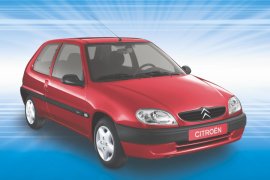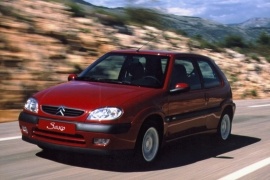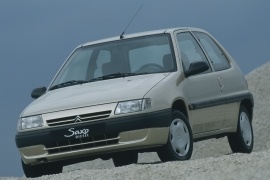CITROEN Saxo 3 doors Models/Series Timeline, Specifications & Photos
First production year: 1996
Engines: Gasoline, Diesel
Body style: Hatchback
In just two years after the model introduction, Citroen managed to sell almost half of million, and then it introduced a facelifted version and kept the selling going.
Citroen introduced the Saxo in 1996 on the same platform as the AX, and it was a badge-engineered product as the Peugeot 106. With strong, over 100,000 units per year, the little Saxo in both three or five doors was a money-maker for the French carmaker. Its sales decreased only in 2003 when its successor, the C2, replaced it.
At the front, the 1998 model featured different headlights with curved lines instead of the angular ones from the 1996 model. The grille sported a wider opening, like a smiling face, with the "double-chevron" chromed badge enlarged in the middle. On its sides, the carmaker replaced the black rubber strips with body-colored ones but kept the trim level badges on the doors. To ensure a better airflow inside the cabin, the Saxo featured pop-out rear side windows. In the back, Citroen applied the same "round-it" theme design for the taillights.
Inside, the main difference was the new steering wheel with a three-spoke design and an airbag. The non-facelifted version sported a two-spoke design. Citroen didn't see any reason to change the rest of the dashboard design, which featured the same rounded lines and triangular-shaped vents.
Under the hood, the French carmaker removed the 1.6-liter gasoline engine from the lineup and left three gasoline and one diesel version on the offer.
Citroen revised the Saxo lineup in 1998 and tried to offer the three-door version with different spices than the five-door, family-oriented version.
The Saxo was a badge-engineered Peugeot 106, which, in turn, was based on the Citroen AX platform. In 1998, Citroen unveiled a facelifted version for the smallest member of its family. That led to a slight increase in sales over the 1997 figures. The sales fell under 100.000 units per year only in 2003, when the car was ready to leave the market and made room for its successor, the C2.
At the front, the 1998 model featured different headlights with curved lines instead of the angular ones from the 1996 model. The grille sported a wider opening, like a smiling face, with the "double-chevron" chromed badge enlarged in the middle. In the three-door version, Citroen re-named the little Saxo as VTS and offered it only with gasoline engines, including a sportier version. In the back, the carmaker mounted a roof-spoiler at the tailgate's top to show its commitment to motorsport.
Inside, the main difference was the new steering wheel with a three-spoke design and an airbag. The non-facelifted version sported a two-spoke design. Citroen didn't see any reason to change the rest of the dashboard design, which featured rounded lines and triangular-shaped vents. For the 120 hp VTR version, the carmaker installed white-dials instruments.
Under the hood, the French carmaker installed a choice of three engines. The base version was a 1.4-liter gasoline unit, while on the other tip of the scale stood the 1.6-liter, 120 hp engine that transformed the little super-mini car into a true hot-hatch.
This was one of the vehicles that revived the French brand Citroen. After years of weak presence in Europe on the small market, the Saxo came up and saved the day. Even though it was the same vehicle as its sibling brother, the Peugeot 106, the Saxo had better success. The different styling made it more appealing to the younger generation. The promotion program made by Citroen in the motorsport arena with the Saxo-Cup boosted sales across Europe.
Small, nimble and light, the Saxo had the advantage of a well-equipped vehicle right from the start. It was launched also in a time when Renault changed its best-selling model, the Renault 5, with the new Clio.
The interior had a wide range of options. For starters, it didn't even have central locking, but on the top models there were bucket seats, air conditioning, and nice stereo systems. Also, on the top versions such as the VTS or the VTR, the light-alloy-wheels were fitted as standard.
The engine range was big, starting with a frugal 50 hp 1-liter engine and going up to a sporty and nimble Saxo VTS, with a 1.6-liter and 120 hp unit. The VTS had a 0-60 mph (97 kph) sprint time in under 8 seconds, which was a very quick time for the era. In 2004, the Saxo ceased production, leading the way for the Citroen C2.


